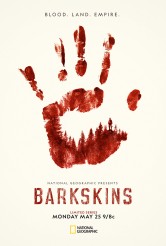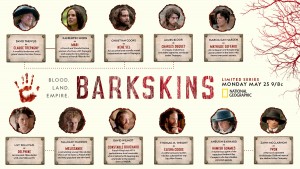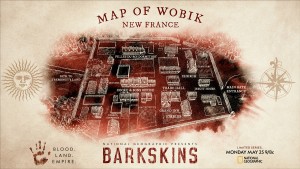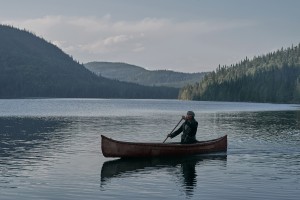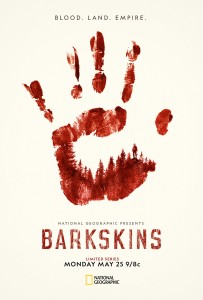BARKSKINS, the series premiering Monday, May 25, on National Geographic, is based on a small section of Annie Proulx’s sprawling 2016 novel. Executive producer Elwood Reid, who adapted BARKSKINS for television and wrote all eight of the episodes, begins in 1670s New France, the territory that will become modern-day Quebec, Canada.
“Barkskins” is a term for indentured servants who are working for their freedom. In the series, these include determined Sel (Christian Cooke) and homesick Duquet (James Bloor), whose services are purchased by eccentric homesteader Trepagny (David Thewlis). The area is contested by the French government, the English Hudson Bay Trading Company, and the Native American tribes whose people have been on the land for thousands of years.
Reid, also a novelist, also developed (with Meredith Stiehm) and executive produced the series THE BRIDGE. Reid has previously been been a writer/executive producer on COLD CASE, the 200s edition of HAWAII FIVE-0, UNDERCOVERS and THE CHI.
In a telephone interview, Reid discusses all things BARKSKINS.
ASSIGNMENT X: Did you read Annie Proulx’s novel BARKSKINS and then think you’d like to make a series, or were you looking at doing something in this period in history, and then found the book?
ELWOOD REID: I was offered the book by [fellow executive producer] Scott Rudin and Nat Geo. I’m a novelist, Annie Proulx is a writer that means a lot. [Proulx’s] THE SHIPPING NEWS was a very, very important book to me when I was a young writer. So my first thing was, “F***, yes, I want to do the book by Annie Proulx.” My second thing was, “I’m not going to pick up or adapt a book by Annie Proulx, an idol of mine, unless I think I can make something great.” I just didn’t want to take her name and then disappoint her. Also, I’d worked with [National Geographic executive vice-president] Carolyn Bernstein on THE BRIDGE [when Bernstein was at FX], so I knew there were lot of good ideas. There was Scott Rudin, and there was Carolyn Bernstein at Nat Geo. I was like, “If you’re ever going to adapt a seven-hundred-page historical novel by Annie Proulx, this was the group of people to do it with.”
AX: Your BARKSKINS focuses on a section of the novel, rather than the book as a whole. So how did you decide on that section? Was that the section National Geo was interested in, or did they say to you, “Do this however you see fit”?
REID: I have to say, they didn’t tell me to do anything. They said, “Here’s this book, we don’t know if it’s even adaptable, because it covers three-hundred-plus years of history.” She covers a decade in a paragraph. So my challenge in reading it was, how do you adapt this? There are characters that die in one sentence, and then new characters come up.
So I took a deep breath. I thought, “Well, the first hundred pages, the beginning of the book, the inciting incident for a lot of the stuff that follows, it’s an introduction to this time period and this weird place in North America.” It was very focused. But then I had to invent a fair amount of plot and characters that were not in the book at all, and bring them in to give some gasoline to those characters that Annie had [created]. So that was the approach. Again, everyone all the way down the line was very supportive of that.
Having written my own novels, and had them adapted by other people, and adapting other people’s books, you’re very nervous. Because some writers will say, “I don’t want you to change a goddamn word. I don’t want you to screw up my book.” I think the best adaptations take a book and riff on them. They take the tone of a book, and the vibe of a book, and make a TV show. In my opinion, I’m never going to improve on Annie Proulx’s book. Books are my primary source of entertainment. I read books constantly. The job of a television adaptation of a book is to take that book, the essence of it, and make a TV show out of it. So there’s a lot of cutting, there’s a lot of addition, there’s a lot of riffing. And I think, to Annie’s credit, she was very supportive. She was like, “I already wrote the book, you have the book, go have fun.” And so I felt that creative license to go out and try to create a kickass TV show out of this book.
AX: Which characters are hers, which characters are yours, and are any of them real people?
REID: I don’t believe any of them are real people, unless she didn’t tell me. The Hudson Bay Trading Company is real, but the characters that exist in the book are Trepagny, who’s the David Thewlis character, Sel and Duquet, the two indentured servants that come there, Mari [Trepagny’s common-law wife, played by Kaniehtiio Horn] is a character in the book, and Melissande [a young Frenchwoman seeking a husband, played by Tallulah Haddon] is a character in the book. Everything else I invented to add plot around that group of people.
AX: To ask a tweaky question, Thomas M. Wright, who worked with you on THE BRIDGE, plays a character called Elisha Cooke. Is the character named after the actor Elisha Cook Jr.?
REID: [laughs] How did you know? There’s a character named Cooke in the book. Elisha Cook is an actor I’ve always loved. Those two things go together really well.
AX: How many different character factions are there in BARKSKINS? And does Trepagny count as his own faction?
REID: Historically, there were of course other factions, but there were multiple [Native American] tribes up there. And each of the tribes had their own take on trading with the Europeans, and the interactions with the Church. Each one of those is distinct. I boiled it down to the Wendat and the Iroquois nations. The Iroquois were historically a little bit more aligned with the English. The English were trying to push up through the Great Lakes region to push the French out. And then within the French, you had the Jesuits, and the Ursulines, who were religious orders that were sent there by the king to help convert Native American populations to Catholicism. And they were also there economically to put people on the land.
And then you have Trepagny. The way I always use him as a character is, he is this crazy dreamer. And if you look into the founding of most places, the West included, a lot of people go out there because they’re seekers, they’re trying to build an empire, they’re trying to form a religion, they have some vision in their head that they’re trying to get out. That was very much who Trepagny was. What makes Trepagny so tricky and difficult for people is, they don’t understand what he’s after. He’s got this vision in his head, and he thinks he can achieve that vision in New France. Where the British were like, “Hey, we can trade, and get beaver, and we can get ship-masting, and we can make money and get rich.” Trepagny didn’t play by those rules, so it made him an oddball.
AX: Then there are Goames, played by Aneurin Barnard, and Yvon, played by Zahn McClarnon. Are they their own faction? Are they really aligned, as they claim, with the Hudson Bay Trading Company, or are they off on a mission of their own?
REID: They represent a company, which was a real company at the time. The Hudson Bay Trading Company was like the East India Trading Company. They were a fairly rapacious company that was located around the Great Lakes that was trying to tie up trade. And there were a couple of other trade companies like it, trying to tie up trade all over the region. But the big lie in the show, and I’m not giving too much away, is that Goames, a Hudson Bay man, is there to find his brother-in-law, who also works for the company and has disappeared. He’s not told the company that he’s up there looking for him. It becomes a disastrous result for him that he’s up there doing this.
AX: How much did you know about the 1670s in North America, and how much did you have to research?
REID: In North America, we think, “Oh, there are all these Western stories. There’s the settlement, the ‘taming’ of the West.” The rest of the country had been settled for [centuries] before they started to push West. This era of history, this is the first contact of Europeans coming down, through Jamestown. It’s this period of history that gets elided. And when you go up there [to Quebec], and you see the landscapes that these people were trying to recreate French society in, it’s crazy. They have summer for three months out of the year. It was bug-infested. It was harsh. The forest was impenetrable. There were multiple tribes, with English coming up from everywhere, who were trying to push them out of the territory.
So I felt like I’d hit the gold mine. I felt like, “Holy s***, this is a period of history that there’s one book and one TV show that I know of that came from it. I just have not seen this era of history in television.” So as a writer, I was super-excited about it. I get to explore this huge, bloody, exciting history, with all these factions that no one else has done. I’ve written Westerns, I’m working on a book right now that’s a Western, but it feels like it’s well-tilled soil. This was like, “It’s virgin territory. Oh, my God, I can’t believe no one’s done this before.”
AX: Did you have a writers’ room for BARKSKINS, or did you just write the whole thing?
REID: I had a writers’ room, but particularly with works like this, the language is really pushed. My hand is in everything. My name is on every script – I share credit with some of the other writers [including Sheri Holman and Jason Sack]. The writers’ room is there to help generate ideas, and bounce ideas off of, but I knew going in that this world, adapting Annie Proulx, there had to be this continuity of tone and language. And so I spent a lot of time agonizing over really wanting to do her story justice. When you’re doing a literary adaptation like this, I think the language and the tone has to be consistent. Maybe because I’m so attuned as a writer, I can always tell the shows that are written by committee, versus the shows that are written by a singular voice. So I knew going in I was going to have to do the lion’s share of the writing.
AX: Well, BARKSKINS has to dramatize both individual characters and national social forces …
REID: The English had landed in Halifax, Nova Scotia, and were working their way northward through Canada there, and there were actually some Dutch in the area, too. It was still a very unsettled territory. There is an episode that takes place in quote “Canada.” That’s part of the dramatic rub of the show that I was trying to get at. There was this incredibly wild – on the face of it – inhospitable country that was very rich in resources, but had been settled by many, many tribes, who had been living there for thousands and thousands of years. And so there was essentially a giant land grab going. These different factions were hoping to control the incredibly rich Seehorn Seaway. That was the goal of these factions. And France really thought they were going to have a new France in Canada. It didn’t turn out that way, but when you go there, the French language, the French culture, is still imprinted in that area.
You feel it when you go there. The [Quebecois] people I shot with view themselves as Canadians, but I never heard any of them say, “I’m a Canadian.” They’re all Quebecois. And oftentimes, they would refer to themselves as French. Because the people that were working on my show, my cast and crew who came from that area, I was telling the story of their relatives. They all traced themselves back to the settlement in that area from the French. So it was, again, an American going up to this region meant historically a lot to these people. I felt the burden of trying to tell their story.
AX: Were they excited that somebody was trying to tell the story, or were they like, “Wait, you’re American, this isn’t your story to tell …”?
REID: No. Again, I think it’s an American-centric view of the world, and this goes for most things – music, art, everything else – there’s this amazing, vibrant part of history that most Americans are incredibly ignorant about. And to the Quebecois, to the French-Canadians, it’s this amazing untold of these people who came there with nothing, to this really hostile and inhospitable landscape, and founded a civilization. I can’t speak for all of them, I don’t know, but they were very welcoming and excited. I think there was a little bit of puzzlement. They were like, “Why doesn’t anybody know? Why does an American want to tell this story?” Because they think Americans only care about the West, or the American Revolution. So I think there was a little bit of that preconceived notion. But I’ve always been fascinated by that era. So to me, it was an incredibly exciting era in history, and again, one that had not been shown on television. So it was very, very attractive to me.
AX: How many episodes are there in BARKSKINS Season 1?
REID: It’s funny, because we were originally a ten-episode show, and I had planned ten episodes of the story, but again, because we shot this in a real location, what ended up happening was, we went up there, and I could not get my sets built until July. I couldn’t do it. So at first, I cut the episodes to nine. I told the studio, “Well, we’re going to do nine episodes.” And then the building took longer and longer and longer. And I realized, I maybe could have shot nine episodes, but we would have been doing it in two feet of snow, because I finished shooting in October, and a week later, a huge snowstorm hit. So I cut it to eight episodes, because of the weather, and because of [time it took for] the set builds. We built everything practical. Everything you see up there, we built.
AX: If BARKSKINS continues, is it going to follow the path off the book, or is it going to go off in the direction that the original characters are setting?
REID: It will go off in the direction of the original characters. That would be the plan. Because the cast I assembled is amazing. It’s a dream cast. Whenever you’re doing a TV show, it’s just like writing a book, the hardest thing is to set the show up. I would hate to leave these characters, and not finish telling their stories. When you get to the end of this season, you’ll see I left all the characters in incredibly difficult, tricky situations.
AX: Ideally, how many seasons would you like to see BARKSKINS run?
REID: I’m not one of those writers who says, “I want it to run forever, twenty seasons, and make a lot of money.” I think stories have finite beginnings and ends. And I definitely feel that with this story. I think you could accomplish a really great, satisfying story in four seasons, maybe five at the most. I’ve always admired those shows that put a cap on it. They say, “We’re going to end it,” and you write to the ending, if possible. I get frustrated by shows that feel like they’re just producing episodes to produce episodes. I like when a writer, a singular-voice writer, says, “I’m going to tell you a great story. So you have to pay attention to every single episode, or chapter, of this story.” The writer ends the show because it’s time to end the show.
You have to have the guts as a writer to tell the studio or the network, “I envision the ending in X amount of seasons.” And you work really hard to get there, and then tell a really good story doing that. I’m very particular. I try not to waste a minute of television. I know how precious that time is, storytelling for people. I don’t ever want you to feel like, “This was a waste of my time, it was boring.” I try to pack as much as I can into every episode of television.
AX: And what would you most like people to know about BARKSKINS?
REID: That it’s not your average period show, that, yeah, there are some people in dresses and there are some dances, but there are also guys in the woods with axes. There are exciting set pieces. It’s a big, ambitious show that I hope is honoring Annie Proulx’s novel. It’s fun.
Follow us on Twitter at ASSIGNMENT X
Like us on Facebook at ASSIGNMENT X
Article Source: Assignment X
Article: Exclusive Interview with BARSKINS creator Elwood Reid
Related Posts:




